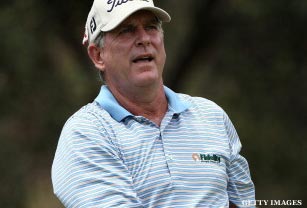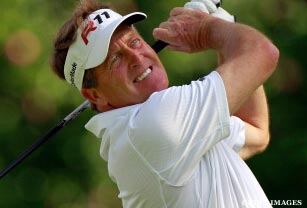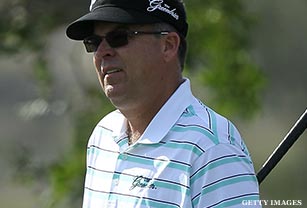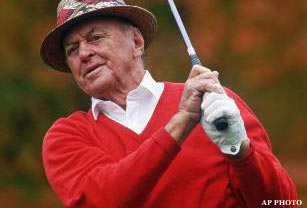When Tiger Woods’ latest reign as the world’s No. 1 golfer ended in 2010, there was no shortage of contenders for the honor -- from old names like Phil Mickelson and Lee Westwood (the new No. 1) to youngsters like Martin Kaymer. But one of the more surprising subplots was the disappearance of a golfer who wasn’t in position to overtake him: old nemesis Vijay Singh.
Singh, who turns 48 on Feb. 22, isn’t used to being an afterthought. Many forget that it was Singh, not Mickelson, who rose to the peak of the golf rankings the last time Tiger was struggling with his game. Singh held the top spot for three different stints totaling 32 weeks in the middle of the decade before Tiger reclaimed control for good in June 2005.
Yet the big Fijian wasn’t in the conversation this time. Not even close. He has fallen all the way to No. 88 in the rankings, coming off a season in which he recorded just two top 10s and needed a special exemption just to qualify for the U.S. Open. The golfer who holds the PGA Tour record with 22 wins after his 40th birthday hasn’t hoisted a trophy since capturing the first two events of the FedEx Cup playoffs in 2008.
Singh proved there was life after 40 for top professional golfers. But his balky back and unreliable putter have brought his career to a crossroads. Can Singh still be a factor a couple of years before he hits the half-century mark? Or should he be counting down the days until he can tee it up on the Champions Tour?
Luckily for Singh, there is precedent for a resurgence at his age. Here are the five golfers who had the most PGA Tour success after they turned 48. (Apologies to Ray Floyd, whose win at Doral and second-place Masters finish at age 50 were just short of making the cut, and Tom Watson, for his amazing and unforgettable performance at the 2009 British Open.)

No. 5 Jay Haas
Haas is a particularly interesting case. His ninth and final PGA Tour win came in 1993, when he was 39. From 2000-2002, he had only three top 10 finishes and never placed higher than 92nd on the money list. Then, just when it looked like Haas was biding his time until the Champions Tour, he broke out with two runner-up finishes and earned over $2.5 million in 2003, giving him his highest money list spot in 21 years. The soon-to-be-50 year old also qualified for the Presidents’ Cup at the end of the year, winning his singles match and helping the U.S. side retain the Cup. Haas also made more than $2 million in 2004 and was one of the top 20 golfers in the world before slowly transitioning to full-time status on the tour with the rest of the 50-and-over crowd.

No. 4 Fred Funk
The former Maryland golf coach’s career might be even more unusual. His first full season on the PGA Tour wasn’t until he was 33, but he’s more than made up for the lost time. Funk is far from the longest hitter, but his accuracy off the tee and superb iron play allowed his game to peak after he turned 48. He won the biggest tournament of his career, the Players Championship at TPC Sawgrass, one year before he was eligible to join the Champions Tour. He also captured two other less prestigious events -- the 2004 Southern Farm Bureau Classic and 2007 Mayakoba Golf Classic, at which he prevailed in a playoff. Funk seems to be finally slowing down and playing almost full-time with his fellow seniors, but write him off at your own risk. His story doesn’t seem to be over, if this year’s performance at the Players Championship (tied for 15th, five strokes off the lead after three rounds) is any indication.

No. 3 Julius Boros
The fact that the oldest major winner in history pops up at No. 3 speaks to how strong the next two on this list are, but Boros was remarkable as he aged. The then-48-year-old lurked on the fringes of contention for the first three rounds of the 1968 PGA Championship before shooting a 69 -- the second-best round of the day -- on Sunday to overcome a two-stroke deficit. That victory denied Arnold Palmer, who tied for second, a chance to win the only major that eluded him during his career. Later that year, Boros won his 18th and final PGA Tour event at the Westchester Classic, which had the biggest purse on Tour at the time. He later lost to Gene Littler in a playoff at the 1975 Westchester Classic, narrowly missing a chance to be the oldest tournament winner as well. Two years before that, he had been in the mix during the third round of the U.S. Open.

No. 2 Kenny Perry
With a torn ACL sidelining Tiger for the second half of 2008, it’s reasonable to suggest that Kenny Perry might’ve been the top golfer in the world for about five months. During an stretch of eight tournaments right before he turned 48, Perry picked up three wins, a loss in a playoff, and two sixth-place finishes. Then he realized his dream by leading the U.S. Ryder Cup team to victory in his home state of Kentucky that September. Perry’s success continued the following year, including two more wins -- at the FBR Open and Travelers Championship. He also famously squandered a two-shot lead with two holes to play at the Masters, falling in a three-man playoff and coming up just short of displacing Boros as the oldest golfer to win a major. Perry still managed to finish fifth on the money list for the second straight year.

No. 1 Sam Snead
The man who has won more PGA Tour events is also the oldest tournament champion. His triumph in the 1965 Greensboro Open -- less than two months shy of his 53rd birthday -- gave him victory No. 82 (eight of which came in Greensboro alone) and helped him finish in the top 25 on the money list. Snead collected three other titles after age 48, but his accomplishments after he stopped winning are even more impressive. Fueled by a third-place finish at the PGA Championship, he was one of the top 50 earners in 1974 -- as a 62-year-old. He made the cut at the 1979 PGA Championship, the oldest golfer ever to play the weekend at a major. And Snead fired rounds of 67 and 66 during the 1979 Quad Cities Open, making him the first and youngest PGA Tour golfer to shoot his age (67). There’ll never be another one like Slammin’ Sam.




